Featured Comment
First time celebrating 月見! This recipe is easy, super tasty and funny to serve to guests.
★★★★★
– Andrea
Ever seen breakfast turn into a moonlit story? Golden yolks glowing like harvest moons over kake udon, with kamaboko rabbits hopping across the bowl.
This Tsukimi Udon blends cozy bacon-and-egg comfort with Japanese simplicity, and one tiny knife trick that transforms fish cake into art. Ready to learn how?
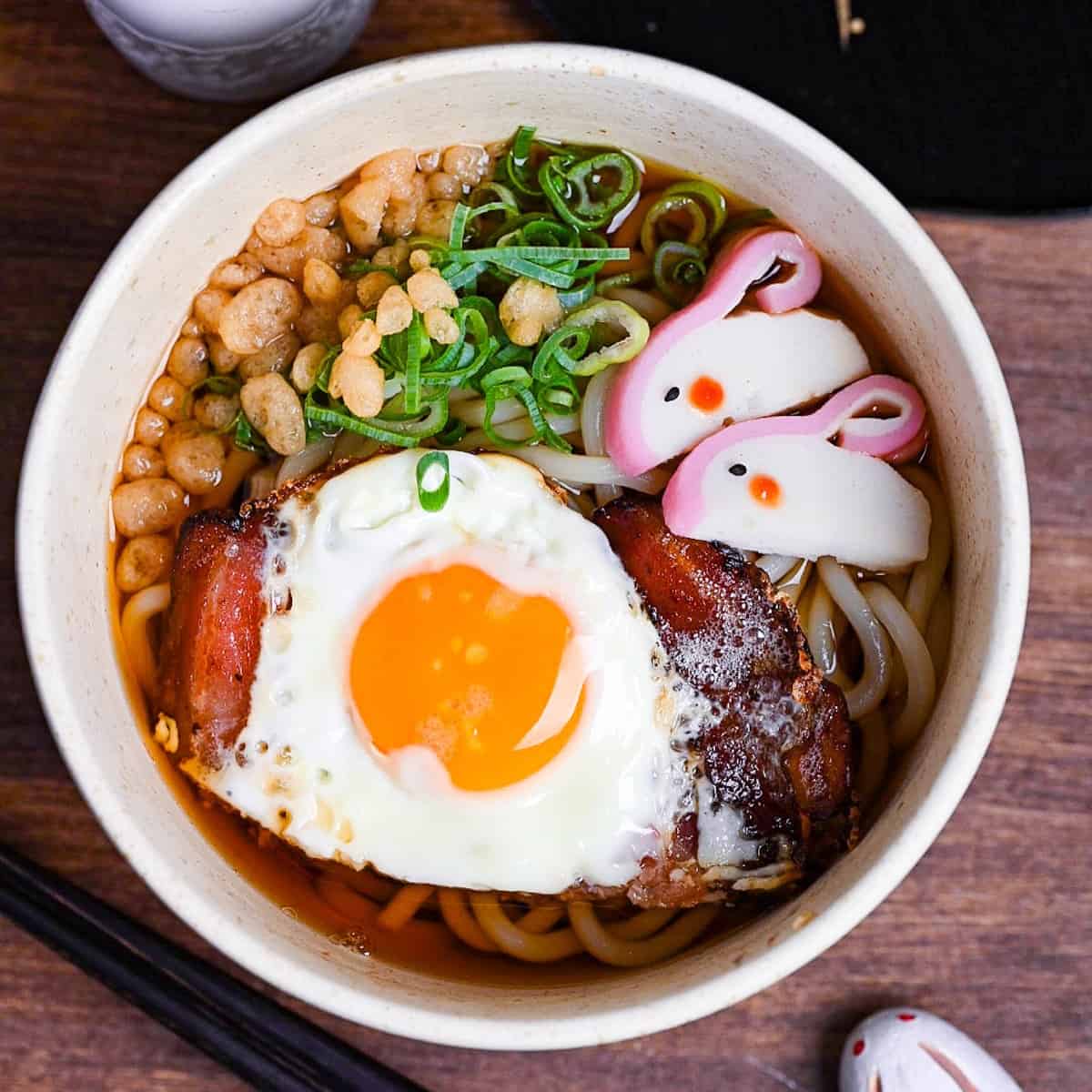
Tsukimi Udon
Recipe Snapshot
- What is it? A comforting bowl of udon topped with bacon, sunny-side eggs, and adorable kamaboko rabbits.
- Flavor profile: Savory, Smoky, Comforting
- Why you’ll love this recipe: The edible kamaboko rabbits turn dinner into a story, while the familiar bacon-and-eggs backbone keeps even picky eaters curious.
- Must-haves: Dashi stock, Egg, Kamaboko fish cake
- Skill Level: Easy
Summarize & Save this content on:

What is Tsukimi Udon?
Tsukimi udon (月見うどん) is a comforting bowl of udon noodles served in a light broth and topped with an egg that symbolizes the full moon. The yolk represents the glowing moon, while the white stands for drifting clouds. A visual tribute to Japan’s “tsukimi,” or moon-viewing tradition.
The name and idea come from centuries-old autumn festivals where people would gather to appreciate the beauty of the full moon. Offerings like tsukimi dango were made to celebrate the season, a custom that still continues today.
This moon-inspired theme even extends to modern creations like the tsukimi burger, proving how deeply moon viewing has woven itself into both traditional and pop food culture in Japan.
Tsukimi Udon Ingredients
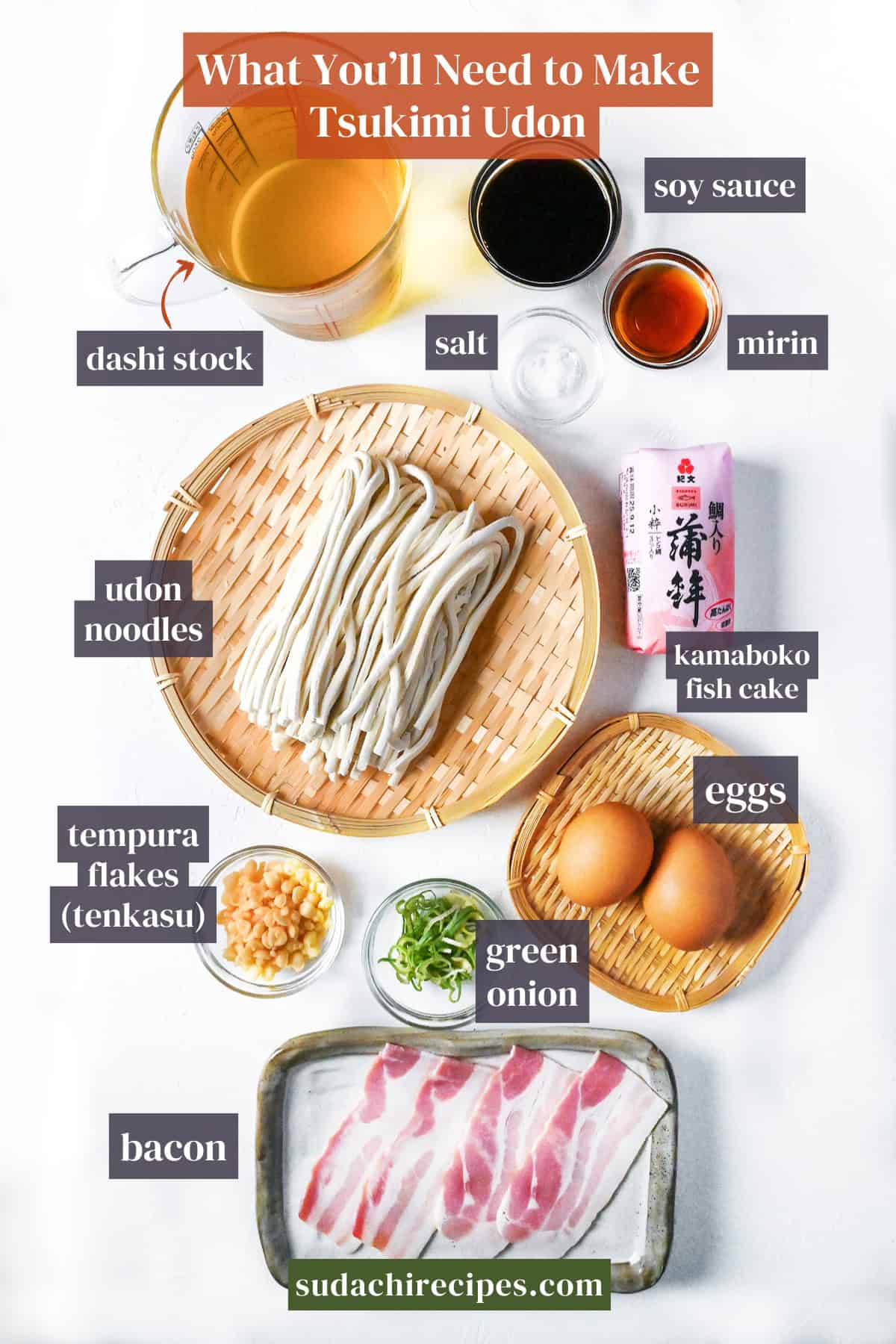
- Udon Noodles: Fresh, frozen, or dried, use whatever you can find easiest at your local Asian grocer or even regular supermarkets. I personally skip dried udon because the texture tends to be mushy. For weeknight speed, frozen udon is the best option.
- Kamaboko Fish Cakes: Mild, springy steamed fish cake that adds a clean ocean umami and a pop of white-and-pink. Perfect if you want to cut adorable bunny shapes for topping. It’s often stocked at large Asian or Japanese grocers in the refrigerated fish-cake section.
- Dashi Stock: Use either homemade dashi with kombu and bonito flakes, or a vegan dashi using kombu and dried shiitake mushrooms. If you’re short on time, high-quality dashi packets (the tea-bag style) are a fantastic shortcut. Instant dashi powder can work in a pinch.
How to Make My Tsukimi Udon
If you prefer to watch the process in action, check out my YouTube video of this Tsukimi Udon recipe!
Before you start: Prepare your dashi stock either using my homemade dashi stock recipe or dashi packets.
i. Combine dashi stock, Japanese soy sauce, and mirin in a pot and bring to a steady boil at 100℃ (212°F). Let it bubble 1-2 minutes to burn off the alcohol of mirin. You’ll notice the alcoholic aroma fade to mellow.
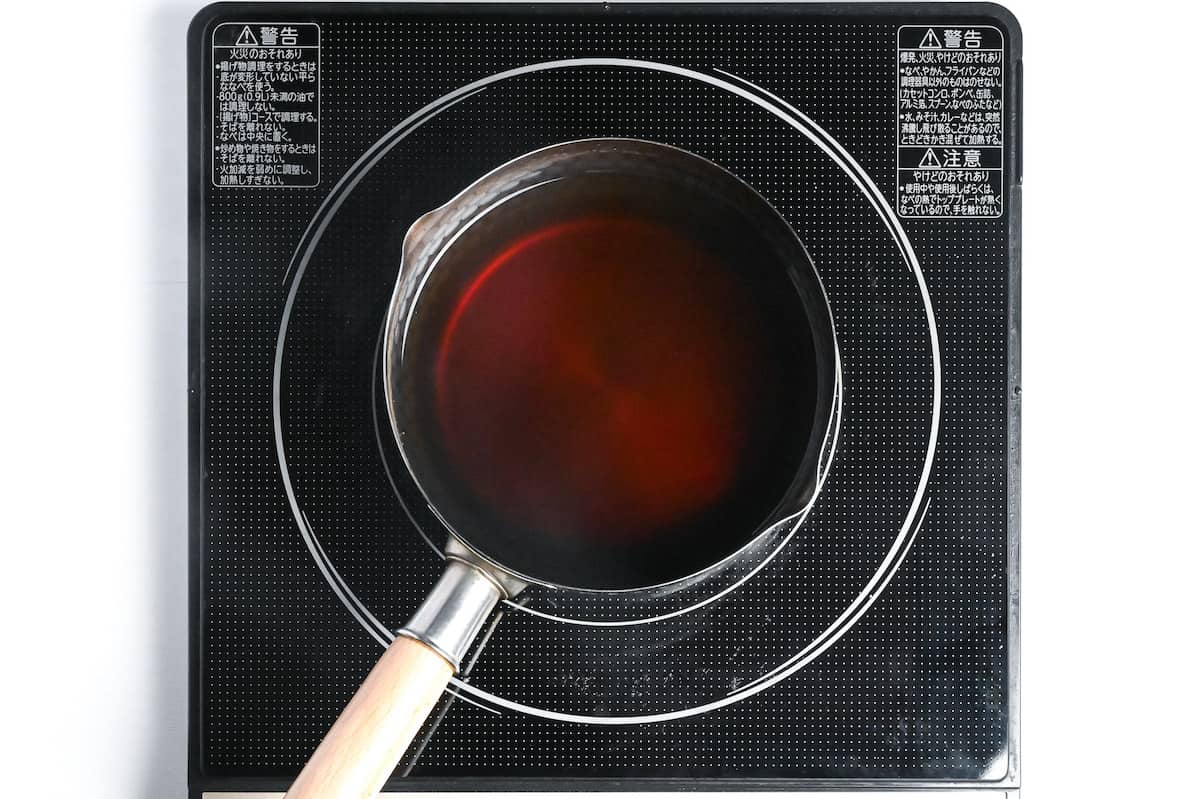
ii. Turn off the heat and add salt. Mix until dissolved and leave on the warm stove for later. Reheat right before serving if necessary.

i. Heat a skillet on medium, lay the bacon slices in a single layer and flip once edges are deep mahogany and begin to crisp up.

ii. Reduce the skillet to medium-low and crack in the eggs. Cook until whites are just set and edges lightly frilly, 2-4 minutes.

iii. For set whites with tender yolks, you can cover the pan for the last 30-60 seconds so trapped steam finishes the tops. If browning races ahead, nudge the heat down.
i. Bring a large pot of water to a rolling 100℃ (212°F) boil. Boil udon per the package until bouncy with no hard core, then drain and briefly rinse under cold running water to wash off excess starch and restore snap.
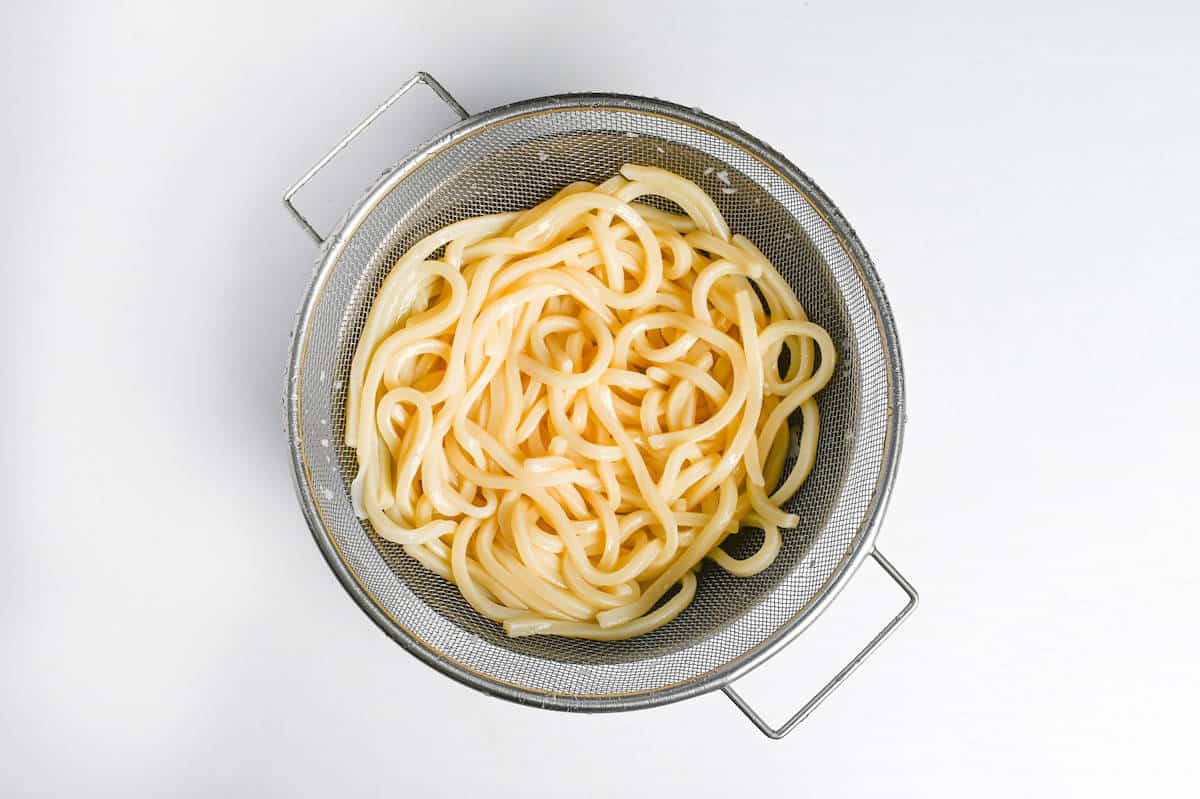
ii. Dip back into hot water about 90℃ (194°F) for 10-15 seconds to rewarm without diluting the broth.
A quick cold rinse tightens texture and keeps the soup clear. The short hot dip brings noodles back to serving temperature without turning them mushy. This two-step is a reliable weeknight upgrade.
i. Slice two 7-10 mm pieces of kamaboko per bowl. Along the pink rim, cut toward the center without severing.

ii. Open the flap, cut it down the middle to form “ears.”

iii. Then fold both under and tuck the edge into the center slit so they stand.

iv. Press in a black sesame “eye” and dot a chopstick in ketchup for a tiny blush.

Cute garnishes can nudge hesitant eaters to try a new bowl, ideal if you’re introducing dashi to kids. You can make the rabbits up to a day ahead and refrigerate covered to prevent drying out.
i. Reheat the broth to a gentle 95℃ (203°F) simmer, then divide hot noodles and broth into bowls. Top each with two strips of bacon, one sunny-side-up egg, two kamaboko rabbits, chopped green onion, and a small handful of tenkasu (crispy tempura flakes).

ii. Taste the broth. If too salty to your liking, add a splash of hot water, if too light, finish with a few drops of soy.

Essential Tips & Tricks
- Boil the broth just long enough (1-2 minutes) to remove the mirin’s alcohol.
- When cooking udon, rinse under cold water right after boiling to remove excess starch, then dip quickly in hot water to rewarm.
- Reheat broth only to a light simmer (about 95℃ / 203°F) before serving.
With these simple tips in mind, you’re set for success every time you make tsukimi udon.
Storage & Meal Prep
Fridge: Store broth and cooked udon separately in airtight containers for up to 2 days. Do not store the egg, bacon, or garnishes with the soup. These components must be freshly prepared before serving.
Freezer: Freeze the dashi broth alone in a freezer-safe container for up to 1 month. Do not freeze cooked udon, eggs, bacon, or kamaboko.
Meal Prep: You can prepare the dashi broth up to 3 days in advance and refrigerate it in an airtight container. Slice the kamaboko rabbits and store them covered in the fridge for up to 2 days. Cook bacon 1 day ahead and refrigerate. Re-crisp in a skillet before serving. However, udon and eggs must be cooked fresh.
Reheating: Reheat broth gently on the stovetop over medium-low heat until steaming. Do not boil vigorously.
What to Serve With This Recipe
Tsukimi Udon Q&A
Across East Asia, people have long “seen” a rabbit in the moon’s shadows. In China the rabbit is said to pound an elixir of immortality with a mortar and pestle, in Japan the rabbit is imagined pounding rice cakes (mochi). Research on historical texts and artworks suggests the “mochi-pounding moon rabbit” became common in Japan by the early 1700s (Edo mid-period), likely spread by Chinese-influenced publications and evolving depictions of the rabbit and mortar. Earlier Japanese examples of a moon rabbit appear as far back as the Asuka period (7th century), with further Buddhist imagery in Kamakura-Muromachi eras.
Tsukimi (moon viewing) is a traditional Japanese observance of the harvest moon, typically on the 15th night of the eighth lunar month, celebrated as the “Mid-Autumn Moon.” It originated from Chinese mid-autumn festivities and, in Japan, became a courtly Heian-period custom of poetry and music before spreading to common households by the Edo period. A related celebration on the 13th night of the ninth lunar month is also observed.
Offerings traditionally include rice dumplings (dango), seasonal produce, and the “autumn seven flowers”: susuki (pampas grass), hagi (bush clover), kuzu (kudzu), nadeshiko (dianthus), ominae shi (patrinia), fujibakama (thoroughwort), and kikyō (balloon flower). Dango are often set out as 12 pieces in a normal year or 13 in a leap year, alongside autumn fruits (persimmon, pear, chestnut) and vegetables (taro, edamame), arranged on a small stand to welcome the rising moon.

More Japanese Udon Recipes
Want more inspiration? Explore my collection of easy udon noodle recipes for any home cook to master and enjoy!
Did You Try This Recipe?
I would love to hear your thoughts!
💬 Leave a review and ⭐️ rating in the comments below. 📷 I also love to see your photos – submit them here!
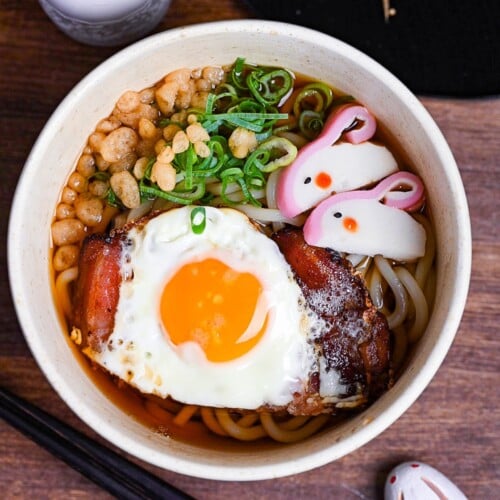
Tsukimi Udon (Moon Gazing Udon with Egg)
Ingredients
Broth
- 500 ml dashi stock
- 2½ tbsp Japanese soy sauce (koikuchi shoyu)
- 1 tbsp mirin
- ¼ tsp salt adjust after tasting the broth
Noodles and Toppings
- 4 rashers bacon streaky
- 2 eggs fresh or pasteurized if serving runny yolk
- 4 slices kamaboko fish cake pink-white variety
- 2 portions udon noodles fresh or frozen recommended
- finely chopped green onions
- tempura flakes (tenkasu)
My recommended brands of ingredients and seasonings can be found in my Japanese pantry guide.
Can’t find certain Japanese ingredients? See my substitution guide here.
Instructions
- Pour 500 ml dashi stock into a saucepan and add 2½ tbsp Japanese soy sauce (koikuchi shoyu), 1 tbsp mirin and bring to boil over a high heat. Let it boil for 1-2 minutes.

- Turn off the heat and add ¼ tsp salt. Mix well. Reheat before serving if necessary.

- Add 4 rashers bacon to a frying pan heated on medium and fry until crispy on both sides.

- Crack 2 eggs into the pan and fry sunny side up until cooked to your liking. (If you prefer the yolk cooked, flip or steam with a lid.)

- Boil 2 portions udon noodles according to the instructions on the packaging. Drain and rinse with fresh hot water to remove the excess starch.

- Take 4 slices kamaboko fish cake and cut along the bottom of the pink line until halfway.

- Place the flap flat on the chopping board and cut through the middle.

- Fold them under so the edge is in the middle.

- Give the rabbit a face by placing one sesame seed for the eye. Dip a chopstick into ketchup and dab it under the eye for rosy cheeks.

- Divide the noodles and broth evenly into serving bowls and top each portion with 2 slices of bacon, one fried egg, 2 kamaboko rabbits, finely chopped green onions and tempura flakes (tenkasu). Enjoy!

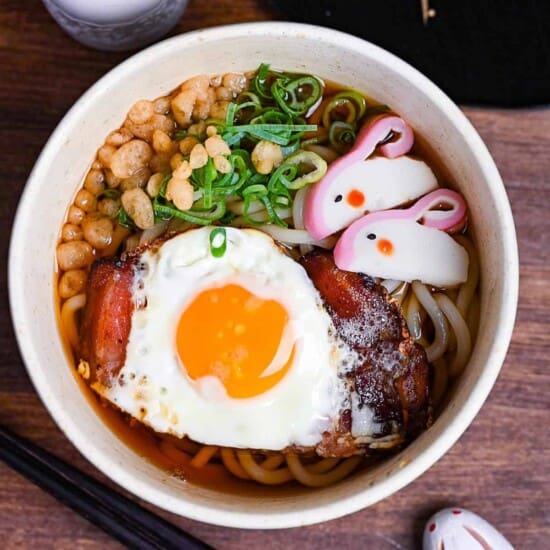




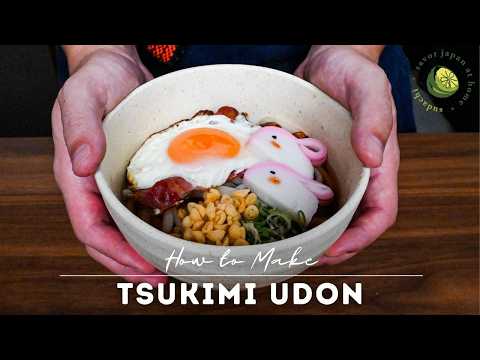
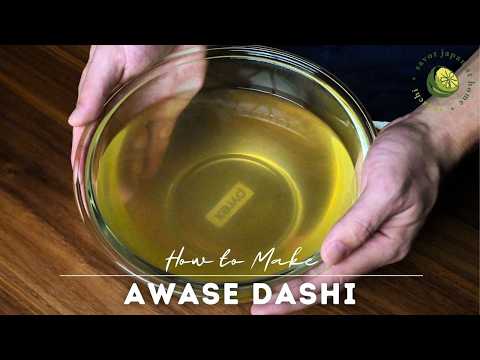
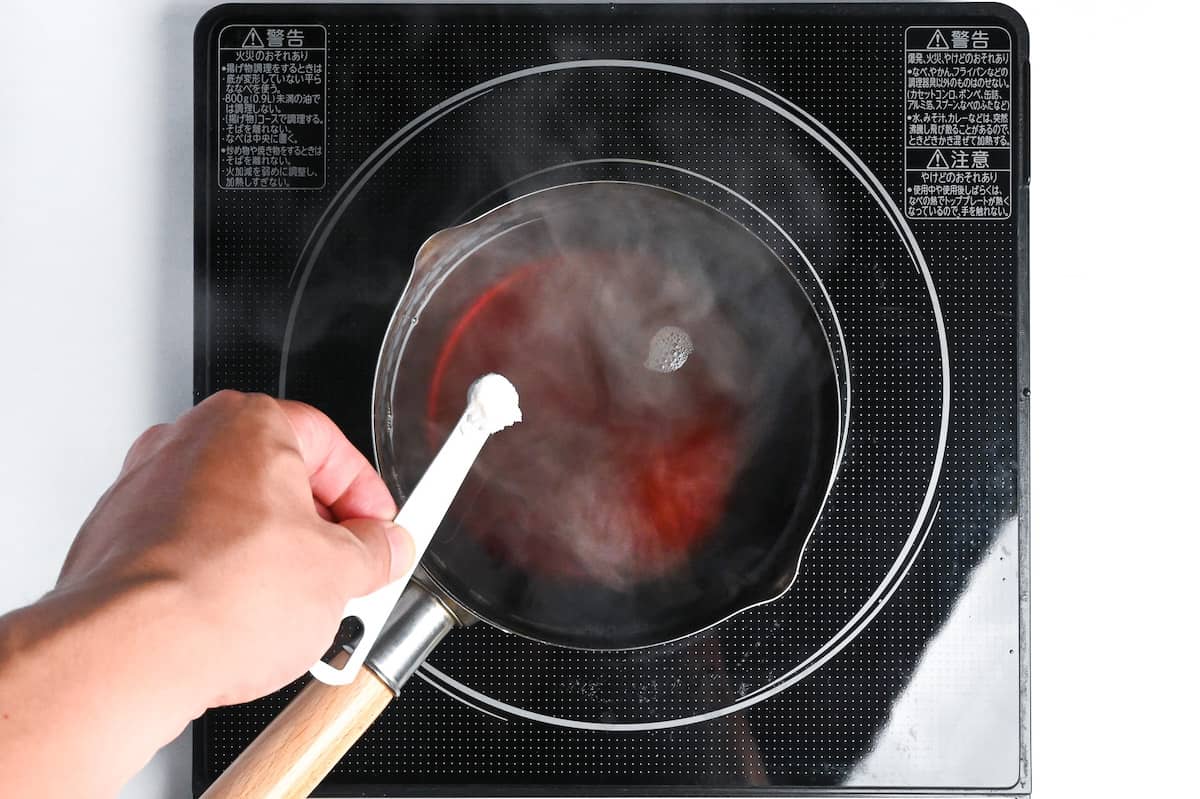
First time celebrating 月見!
This recipe is easy, super tasty and funny to serve to guests.
Unfortunately I couldn’t find the kamaboko so the rabbits are a bit strange ahahahah
Hi Andrea,
Thank you so much for trying this recipe to celebrate Tsukimi! I’m so happy to hear that you enjoyed both making and serving it. Haha, even without the kamaboko, Iyour creative rabbits are looking absolutely adorable! 🙂
Yuto